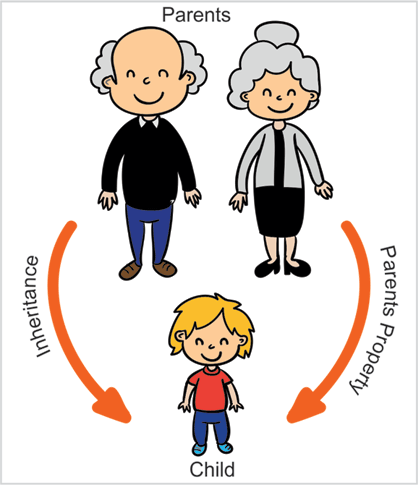📝 Multiple Inheritance in Python 🐍✨#

In object-oriented programming, multiple inheritance allows a class to inherit from more than one parent class. While this can offer flexibility and code reuse, it also introduces complexities (like the diamond problem 💎) that are important to understand—especially in engineering contexts where software systems often reflect complex physical or logical relationships. ⚙️🔧
What Is Multiple Inheritance?#
Definition
A class derives from two or more parent classes, inheriting attributes and methods from each.
Example Syntax
class ClassA:
pass
class ClassB:
pass
class ClassC(ClassA, ClassB):
pass
Why Use It?
In an engineering project, you might have a class that needs functionality from two distinct domains, such as:
MechanicalSystem (managing mechanical operations)
CommunicationSystem (handling signal processing or network protocols)
A child class (e.g., AdvancedRobot) could inherit from both to combine these capabilities.
Engineering Context: Combining Domains#
Example Scenario#
class MechanicalSystem:
def activate_mechanism(self):
print("Mechanism activated at default parameters.")
class CommunicationSystem:
def send_signal(self, message):
print(f"Sending signal: {message}")
class AdvancedRobot(MechanicalSystem, CommunicationSystem):
pass
robot = AdvancedRobot()
robot.activate_mechanism() # Inherited from MechanicalSystem
robot.send_signal("Status OK") # Inherited from CommunicationSystem
Mechanism activated at default parameters.
Sending signal: Status OK
Real-World Analogy
A robot on an assembly line that can perform mechanical actions and broadcast system status—both functionalities are necessary for real-time monitoring and control.
Method Resolution Order (MRO)#
When multiple inheritance paths overlap, Python uses the C3 linearization algorithm (a.k.a. MRO) to determine the order in which base classes are searched for attributes and methods.
Check
mro
You can see the resolution order by inspecting the
mroattribute:
print(AdvancedRobot.__mro__)
(<class '__main__.AdvancedRobot'>, <class '__main__.MechanicalSystem'>, <class '__main__.CommunicationSystem'>, <class 'object'>)
Search Path
Python searches the child class first, then the leftmost parent (
MechanicalSystem), then the next parent (CommunicationSystem), and so on up the hierarchy.
The Diamond Problem#
Definition
Occurs when a child class has two or more parents that inherit from the same base class in separate paths, causing a “diamond” shape in the inheritance graph.
Base
/ \
A B
\ /
Child
Example
class Base:
def calibrate(self):
print("Calibrating base system...")
class A(Base):
def calibrate(self):
print("Calibrating in B's style.")
class B(Base):
def calibrate(self):
print("Calibrating in B's style.")
class Child(A, B):
pass
c = Child()
c.calibrate() # Which calibrate() gets called?
Child.__mro__ # Method Resolution Order
Calibrating in B's style.
(__main__.Child, __main__.A, __main__.B, __main__.Base, object)
How Python Resolves It
Python follows the MRO to decide which method is used first. In the example above,
Bis to the right, but due to the MRO,Bmight be visited beforeAifAdoesn’t overridecalibrate().This can lead to subtle bugs if not carefully designed.
Engineering Examples of Multiple Inheritance#
Safety-Critical Systems
Suppose you have a FailSafeSystem class that logs system states and triggers emergency stops, and a DiagnosticSystem class that collects performance metrics.
A specialized class, FactoryRobot, might inherit from both if it needs to integrate safety features and perform real-time diagnostics.
Mixed-Signal Electronics
You might have a DigitalInterface class for reading/writing digital signals, and an AnalogInterface class for analog sensor data.
A MixedSignalBoard class could inherit from both to handle integrated analog-digital IO logic.
Supply Chain / Inventory Control
A WarehouseOperations class might handle physical inventory checks (locations, capacity), while a DataAnalytics class handles forecasting demand.
A new class WarehouseForecastSystem could combine the core features of both.
Best Practices#
Design for Composition Over Inheritance
If two separate functionalities don’t naturally form an is-a relationship, consider composition (having objects as attributes) instead of multiple inheritance.
Avoid Deep Inheritance Trees
Complex class hierarchies are harder to maintain and debug. Keep designs as straightforward as possible.
Explicitly Call Parent Methods
When overriding, use
super()carefully and consistently. In multiple inheritance,super()must follow the MRO to avoid skipping or duplicating calls.
class MechanicalSystem:
def start(self):
print("Mechanical system start")
class ElectricalSystem:
def start(self):
print("Electrical system start")
class HybridSystem(MechanicalSystem, ElectricalSystem):
def start(self):
# super() calls next in MRO: MechanicalSystem first, then ElectricalSystem
super().start()
print("Hybrid system additional start logic...")
hybrid = HybridSystem()
hybrid.start()
Mechanical system start
Hybrid system additional start logic...
Document the MRO
For complex engineering classes, documenting the inheritance diagram can prevent confusion among team members.
Testing
Thoroughly test classes that use multiple inheritance, especially methods that might be defined in multiple parents.
Summary#
Multiple inheritance allows a class to inherit from multiple parents, combining functionalities in a single child class.
Method Resolution Order (MRO) ensures a deterministic path when searching for methods or attributes.
The Diamond Problem arises when two paths to a shared base class conflict, but Python’s MRO helps mitigate it.
Use Cases in Engineering:
Multiple inheritance can be powerful for merging specialized engineering functionalities but requires careful design and awareness of the MRO to avoid conflicts and maintain clarity.

